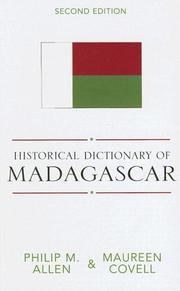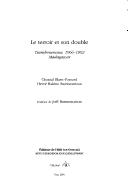| Listing 1 - 10 of 61 | << page >> |
Sort by
|
Book
Abstract | Keywords | Export | Availability | Bookmark
 Loading...
Loading...Choose an application
- Reference Manager
- EndNote
- RefWorks (Direct export to RefWorks)
On Madagascar, the ant genus Pheidole Westwood, 1839 is one of the dominant and most diverse ant genera. Modern studies on the diversity of Madagascan Pheidole has been initiated in 2019 and ended a 100 year-long break in studies on this genus from the island. Based on so far published data, there are 69 known Pheidole species on the island divided into sixteen species-groups. It is estimated that 97% of them are endemic. Here we present a revision of the sikorae species group, which appears to be the most species-rich on Madagascar. Forty-four members of this group are recognised and described, and an illustrated identification key to this group is also presented. At present, there are 109 valid species and subspecies of Pheidole known from Madagascar, but this number is expected to increase with upcoming taxonomic revisions of the species groups not revised in this study.
Pheidole. --- Madagascar.
Periodical
Abstract | Keywords | Export | Availability | Bookmark
 Loading...
Loading...Choose an application
- Reference Manager
- EndNote
- RefWorks (Direct export to RefWorks)
Madagascar --- Economic conditions --- Politics and government --- Madagascar.
Book
ISBN: 1862549354 9781862549357 9781862549043 1862549044 9781862547551 Year: 2010 Publisher: Kent Town, S. Aust. Wakefield Press
Abstract | Keywords | Export | Availability | Bookmark
 Loading...
Loading...Choose an application
- Reference Manager
- EndNote
- RefWorks (Direct export to RefWorks)
I had noticed in Madagascar that many things are called Mad. Would you trust yourself to Mad travel (it sounds rather like what I do), eat in Mad cafe or, a real worry for a white-knuckle flyer, take to the skies with Mad Air, as Air Madagascar is generally known?'In all her travels across the globe, Lydia Laube had always wanted to visit the intriguing island of Madagascar and meet its famous residents, the lemurs. So she hops aboard a French cargo ship, replete with cleaver-wielding cook, to begin a wayward journey. After escapades in Singapore, Egypt, Malta and Italy, Lydia eventually lands
Book
Year: 2013 Publisher: Gembloux Uliège Library
Abstract | Keywords | Export | Availability | Bookmark
 Loading...
Loading...Choose an application
- Reference Manager
- EndNote
- RefWorks (Direct export to RefWorks)
This book (Malagasy silkworms. Ecological and sociological issues) reflects the achievements and scientific activities of the university cooperation project for the 'Management and sustainable enhancement of the endemic silkworm Borocera cajani in a forested area of the Antananarivo region" 'financed by the CIUF-CUD (University Development Cooperation in Belgium). The first section of the work deals with the biological and ecological aspects of silkworms in Madagascar-with emphasis on landibe (Borocera cajanus Vinson, 1863). The second section studies the ecological and botanical dimensions of the habitat of the species, namely, tapia formations (Uapaca bojeri Baill.), by focussing on the silvicultural and botanical aspects, the causes and indicators of its decline, etc. The third section provides information about the valorization of the silk industry and covers a variety of approaches including the compilation of an inventory of edible wild plant resources and their chemical characteristics. This section also looks at the role played by silk in the rural economy, and the knowledge and skills of local communities. The third section ends by taking a look at the socio-institutional context as well as interactions between the players involved in the industry. This work comprises 21 scientific contributions written by 33 authors ; some of them are in english and all the abstracts are written in french and in english. Several chapters have already been published elsewhere. This book is aimed at all those who are passionately interested in Malagasy society and biodiversity, and the potential value of this large island in the context of sustainable development.
Silkworms. --- Silk. --- silkworms --- Madagascar
Book
ISBN: 1536105805 9781536105803 9781536105490 153610549X Year: 2017 Publisher: Hauppauge, New York
Abstract | Keywords | Export | Availability | Bookmark
 Loading...
Loading...Choose an application
- Reference Manager
- EndNote
- RefWorks (Direct export to RefWorks)
Civil war. --- Virginia. --- Madagascar --- Politics and government
Multi
ISSN: 09249389 ISBN: 1283854996 9004242120 9789004242128 9789004240827 9004240829 9781283854993 Year: 2013 Volume: 42 Publisher: Leiden: Brill,
Abstract | Keywords | Export | Availability | Bookmark
 Loading...
Loading...Choose an application
- Reference Manager
- EndNote
- RefWorks (Direct export to RefWorks)
Building God’s Kingdom studies how the encounter with nineteenth century Madagascar influenced the Norwegian Protestant mission. Drawing upon rich Norwegian and Malagasy sources, entangled and multivocal stories are allowed to unfold, revealing the complex dynamics of mission encounters. Tracing Malagasy agency and pursuit of churchly independence in pre-colonial and colonial Madagascar, this study explores the power-struggles between the Malagasy, the missionaries and between the mission in Norway and Madagascar. Through careful attention to context and agency, Karina Hestad Skeie provides new perspectives on the interplay between the local and the global in Christian missions, and on the centrality and restrictions of local agency on mission policy.
Missions, Norwegian --- Norwegian missions --- History --- Madagascar --- Madagaskar --- Democratic Republic of Madagascar --- Repoblika Demokratika n'i Madagaskar --- Repoblika Demokratika Malagasy --- République démocratique de Madagascar --- RDM --- Repoblikan'i Madagasikara --- République de Madagascar --- Repoblikan'i Madakasikara --- Madagasikara --- Republic of Madagascar --- マダガスカル --- Madagasukaru --- מדגסקר --- Malagasy Republic --- Church history --- Missions, Norwegian - Madagascar - History - 19th century. --- Madagascar - Church history - 19th century.
Book
ISBN: 9781107036093 1107036097 9781139565882 9781461955047 1461955041 1139565885 9781107468542 110746854X 9781107465046 1107465044 1107461316 9781107461314 1139889761 9781139889766 1107459257 9781107459250 1107473152 9781107473157 1107472148 9781107472143 Year: 2014 Publisher: Cambridge : Cambridge University Press,
Abstract | Keywords | Export | Availability | Bookmark
 Loading...
Loading...Choose an application
- Reference Manager
- EndNote
- RefWorks (Direct export to RefWorks)
Nineteenth-century highland Madagascar was a place inhabited by the dead as much as the living. Ghosts, ancestors and the possessed were important historical actors alongside local kings and queens, soldiers, traders and missionaries. This book considers the challenges that such actors pose for historical accounts of the past and for thinking about questions of presence and representation. How were the dead made present, and how were they recognized or not? In attending to these multifarious encounters of the nineteenth century, how might we reflect on the ways in which our own history-writing makes the dead present? To tackle these questions, Zoë Crossland tells an anthropological history of highland Madagascar from a perspective rooted in archaeology and Peircean semiotics, as well as in landscape study, oral history and textual sources.
Ethnology --- Semiotics --- Dead --- Landscapes --- Merina (Malagasy people) --- Missions --- Ethnology. --- Missions. --- Religion. --- Semiotics. --- Religious aspects. --- Symbolic aspects --- Symbolic aspects. --- 1800-1899. --- Madagascar --- Imerina (Madagascar) --- Madagascar. --- History --- Religion --- Antimerina (Malagasy people) --- Hova (Malagasy people) --- Hovas --- Imerina (Malagasy people) --- Ovah (Malagasy people) --- Countryside --- Landscape --- Natural scenery --- Scenery --- Scenic landscapes --- Nature --- Dead (in religion, folk-lore, etc.) --- Semeiotics --- Semiology (Linguistics) --- Semantics --- Signs and symbols --- Structuralism (Literary analysis) --- Imerina, Madagascar --- Emyrne (Madagascar) --- Imaïrne (Madagascar) --- Madagaskar --- Democratic Republic of Madagascar --- Repoblika Demokratika n'i Madagaskar --- Repoblika Demokratika Malagasy --- République démocratique de Madagascar --- RDM --- Repoblikan'i Madagasikara --- République de Madagascar --- Repoblikan'i Madakasikara --- Madagasikara --- Republic of Madagascar --- マダガスカル --- Madagasukaru --- מדגסקר --- Malagasy Republic
Periodical
ISSN: 20418345 2042809X ISBN: 129947540X 1841506850 9781841506852 1841504742 9781841504742 Publisher: Bristol
Abstract | Keywords | Export | Availability | Bookmark
 Loading...
Loading...Choose an application
- Reference Manager
- EndNote
- RefWorks (Direct export to RefWorks)
As they set off for Madagascar in 2003, photographer Max Pam and writer Stephen Muecke adopted as their guiding principle the idea of contingency-central to which is the conscious embrace of risk and chance.
Contingency (Philosophy) --- Madagascar --- Description and travel. --- Madagaskar --- Democratic Republic of Madagascar --- Repoblika Demokratika n'i Madagaskar --- Repoblika Demokratika Malagasy --- République démocratique de Madagascar --- RDM --- Repoblikan'i Madagasikara --- République de Madagascar --- Repoblikan'i Madakasikara --- Description and travel --- Madagasikara --- Republic of Madagascar --- マダガスカル --- Madagasukaru --- מדגסקר --- Philosophy --- Malagasy Republic --- Photography, Artistic --- Photography --- Photographie artistique

ISBN: 0810865319 9780810865310 0810846365 9780810846364 Year: 2005 Volume: no. 98 Publisher: Lanham, Md. Scarecrow Press
Abstract | Keywords | Export | Availability | Bookmark
 Loading...
Loading...Choose an application
- Reference Manager
- EndNote
- RefWorks (Direct export to RefWorks)
History & Archaeology --- Regions & Countries - Africa --- Madagascar --- Madagaskar --- Democratic Republic of Madagascar --- Repoblika Demokratika n'i Madagaskar --- Repoblika Demokratika Malagasy --- République démocratique de Madagascar --- RDM --- Repoblikan'i Madagasikara --- République de Madagascar --- Repoblikan'i Madakasikara --- Madagasikara --- Republic of Madagascar --- マダガスカル --- Madagasukaru --- מדגסקר --- Malagasy Republic --- History

ISBN: 2709914522 270992319X 9782709914529 Year: 2000 Publisher: Paris : IRD,
Abstract | Keywords | Export | Availability | Bookmark
 Loading...
Loading...Choose an application
- Reference Manager
- EndNote
- RefWorks (Direct export to RefWorks)
Nitari-dàlana ho amin'ny fandalinana ny ara-kolontsainan'ny rafi-piaraha-monina any Mélanésie, lafiny jeografy, i Joël Bonnemaison. Tamin'ny faritra iray anivon'ny afovoan-tany malagasy, Tsarahonenana (Lemak'Ambohibary, Vakinankaratra) no nanombohany ny fikarohany. Roa polo taona taty aoriana dia niverina tamin'io faritra io i Chantai Blanc Pamard sy Hervé Rakoto Ramiarantsoa, mpikaroka amin'ny taranja jeografy, handinika izay fiovàna nisy nandritry izay fe-potoana izay. Maka lafiny roa ity fiverenana tany an-toerana ity : sady niantefa taminy Tsarahonenana no nijery akaiky an'Andranomangamanga, ilay « efitra » any antendrombohitr'Ankaratra nalain'ny mponina tamin'ny taona 1967. Ity boky ity dia maka endrika teny ifanakalozana amin'izay efa nosoratan'i Joël Bonnemaison. Maro ny loha-hevitra voavaofy ao, miainga avy amin'ny zavaniova hita maso : ny habetsahany mponina voavelon'ny faritra, ny fitantànan'ny eo an-toerana ny tontolo iainana, ny fomba fanao ho fanamasahana ny tany, ny heriny lasitra ara-kolontsaina, ny fitrangàn'ny fari-tany... Ny resaka fampandrosoana no fototra amin'izany rehetra izany. Mitantara ny fianarany ny fomba amam-panaon'ny mpandalina jeografy i Joël Bonnemaison, any amin'ny faran'ny boky, no sady milaza koa ny fahitany indray an'io toerana nanaovany fikarohana voalohany io. Ny heviny manokana mikasika ny fivoaran'ny eny ambanivohitra no velariny. Anisan'ny asa farany nosoratany ity boky ity. Ilay faritra malagasy tsy nohadinoiny no iantefan'izany, ary izay voasoratra dia tena mitondra fampianarana ny amin'ny atao hoe jeografy ara-kolontsaina. Maro ny sary voarakitra ao anatin'ny boky, ary ny mpiandany amy ny (University, ireo izay manana andraikitra amin'ny fampandrosoana, ary koa izay rehetra liana amin'ny tany an-dalam-pandrosoana no iantefany. Mampitohy ny omaly sy ny anio i Tsarahonenana no sady maneho endrika vaovao amin'ny fomba fiainan'ny any ambanivohitra, amin'ny tany an-dalam-pandrosoana. Avant de fonder une géographie…
Agriculture --- Economic aspects --- Farming --- Husbandry --- Industrial arts --- Life sciences --- Food supply --- Land use, Rural --- Agriculture - Economic aspects - Madagascar - Tsarahonenana. --- système agraire --- ruralité --- Madagascar --- Tsarahonenana --- GEOGRAPHIE RURALE --- TERROIR --- AFRIQUE --- DEVELOPPEMENT --- PAYSAGES --- MOBILITE --- MADAGASCAR
| Listing 1 - 10 of 61 | << page >> |
Sort by
|

 Search
Search Feedback
Feedback About UniCat
About UniCat  Help
Help News
News